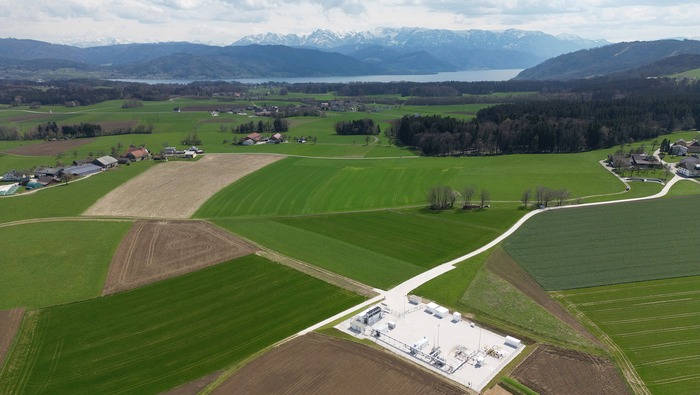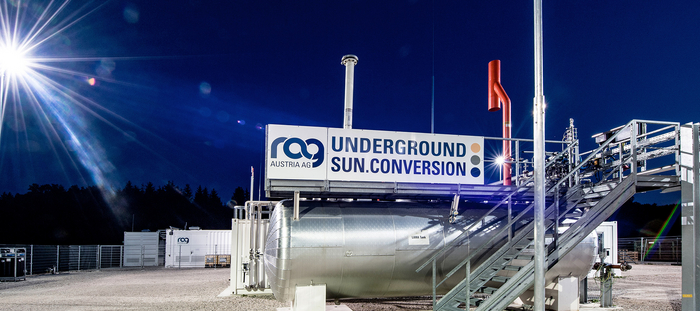

For many years now, RAG has been working tirelessly to develop new technologies that will make it possible to store and utilise large volumes of renewable energy efficiently. Our goal is to maximise security of supply to the fullest extent possible through energy storage and sustainable energy solutions.
As energy generation from erratic renewables such as solar, wind and hydro increases, so does the need for storage facilities that can be used to balance out the seasonal swings from energy surplus (excess solar energy in summer) to deficit (increased demand due to low temperatures and weak sunlight in winter). This is the only way of uncoupling renewable generation and its short-term consumption, which in turn makes it possible to safeguard security of supply all year round and create a needs-based structure on an industrial scale, while at the same time protecting the climate and the environment for future generations. To do this, we aim to make use of existing gas infrastructure, comprising storage, pipelines and wells – this will form the basis of a climate-friendly and affordable renewable energy system in the future.
Our facilities, such as Underground Sun Storage, have shown that it is possible to make renewables storable, while at the same time also safeguarding supplies of these energy sources by converting them into hydrogen – an essential component of the energy future that we have already put into practice. Increased use of solar and wind power, and their conversion and subsequent storage in the form of hydrogen, will also require further spending on technology development and significant investment in storage technologies over the coming years. This will involve expanding hydrogen production in Austria and Europe, as well as the development and extension of high-capacity hydrogen storage facilities.
RAG‘s innovative research projects, including USS 2030, USC Flex Store and Carbon-Cycle Economy Demonstration (C-CED), are aligned with Austria’s climate and energy strategies, as well as with the EU-wide climate protection initiatives and the energy market steering measures required to implement them. As part of its long-term strategy, RAG has introduced a wide-ranging investment programme aimed at significantly reducing its own emissions and converting the company‘s operations to sustainable renewable energy supply, as well as enabling the company to play a decisive part in Europe’s energy transformation by way of pioneering power-to-gas and decarbonisation projects.
![]() Building on our resources, infrastructure and know-how, we are working on sustainable energy solutions that will drive the energy system of the future.
Building on our resources, infrastructure and know-how, we are working on sustainable energy solutions that will drive the energy system of the future.
In the current energy and geopolitical situation, with insecurity surrounding imports of primary products, domestic production of oil and gas has again become a key issue. It is our responsibility to extract and exploit local mineral resources in an eco-friendly way. In addition, oil and gas are major and indispensable raw materials for the chemical industry, and play an important part in economic and industrial policy.
Above all, durable products such as bitumen sheeting, varnishes, paints, oils and lubricants – which, among other things, are used for sustainable energy production (e.g. wind turbines) and e-vehicles – are derived from valuable domestic crude oil and are also essential for non-energy-related applications. What’s more, they help to secure jobs in Austria and create added value. According to the terms of its national concessions, RAG is both entitled and obliged to produce raw materials efficiently and in an environmentally sound manner from the discovered resources in place.
The Austrian Federal Government’s Master Plan Raw Materials 2030 (published in October 2021) explicitly provides for raw materials at existing fields to be extracted as fully as possible.
![]() We believe the future of oil and gas lies in their use as raw materials instead of as heating or transportation fuels. Because for those we’ll have green gas and hydrogen!
We believe the future of oil and gas lies in their use as raw materials instead of as heating or transportation fuels. Because for those we’ll have green gas and hydrogen!

World wide’s most modern facility for efficient carbon and hydrogen production is currently under construction in the RAG Energy Valley. CO2-free production of hydrogen by splitting methane into hydrogen (H2) and carbon (C) requires only a quarter of the renewable energy needed for water electrolysis.
This revolutionary plant will be commissioned in 2023 and will then be able to supply our local facilities – and the wider region – with zero-carbon electricity and heat from the on-site hydrogen-powered CHP station all year round.